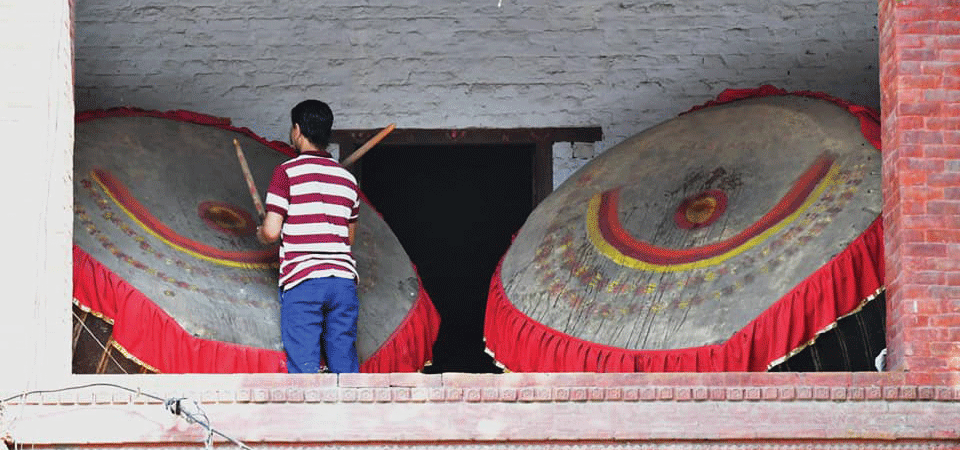These ritual drums may see their last beating

By Aashish Mishra
Kathmandu, June 18: Every morning exactly at 9 o’clock, the Hanumandhoka Durbar Square echoes with the sound of beating drums. Dum…Dum…Dum… two kettle drums beat while the morning rituals are performed in the Degu Taleju Temple. The two ‘Nagaras’ in the open-faced building next to the Hanumandhoka Police Station, are beaten 108 times each.
“For centuries, the Nagaras have signalled the start of the day,” said Yatkha’s Rajendra Maharjan. Maharjan, 72, remembers a time when people did not even eat before hearing the Nagaras because it meant “Degu Taleju had not been worshipped yet.” That is why many who were unaware of the underlying meaning wrongly assumed that the drums were a proclamation to the locals to have breakfast, he informed.
An ox-skin membrane stretched over a hemispherical copper base, the Nagaras, although associated with a Malla-era deity, actually came to Kathmandu with the Shahs. “Prithvi Narayan Shah’s grandfather Bhadra Shah brought the Nagaras to Gorkha from Lamjung when he conquered it. At that time, they were probably used to declare war or to warn citizens of invading foreign armies. The drums came to Kathmandu with Prithvi Narayan Shah and stayed here after his conquest. Later, King Girvana Yuddha began the tradition of playing the drums during the morning worship of Degu Taleju,” explained Suman Pariyar.
Pariyar is a descendant of Prithvi Narayan Shah’s advisor Bise Nagarchi whose family has been playing the drums since the tradition began. A resident of Dhokatole, Kathmandu, Pariyar comes to Basantapur every day, even during the present prohibitory order, to pray to Taleju and Degu Taleju and play the drums.
Pariyar, 36, is proud of his family’s cultural role but is worried that it might not continue. “I will play the drums as long as I live, just like my father before me and his father before him. But my son or grandson might not.”
Asked why, he replied, “Because of the lack of finances.”
The Kathmandu Metropolitan City (KMC) provides Pariyar Rs. 1,500 every month to perform the rituals necessary to play the drums. But this amount, he said, is barely enough to buy incense and flowers.
“And it is a hassle to obtain this amount too,” Pariyar shared with The Rising Nepal. “We need to submit VAT bills which is not possible
for things like flowers and Akshata which we obtain from street vendors.” He added, “Then, there is inefficiency of the bureaucracy. It takes us a whole day just to get our application registered and another few days for it to get signed and approved.” The metro does provide Rs. 20,000 twice a year for Dashain and Chaite Dashain but this again only proves enough to buy goats. “We perform all the other rituals with our own money.”
But what other rituals could there be for just two drums? Turns out, quite a lot. The Pariyars are required to offer animal sacrifices during the two Dashains. They also have to offer a portion of ceremonial food items ‘Bhaag’ during Indra Jatra. An elaborate puja needs to be performed every morning before anyone is even allowed to touch the drums. “All this requires money which we do not get,” Pariyar expressed his worry.
Of course, they would not have had to rely on outside support if the land provided to the drums had been preserved. According to records maintained by Pariyar’s family, there are 174 Ropanis of land in the name of the Nagaras in Charikot, Dolakha and 20 Ropanis in Sanagaun, Lalitpur. Similarly, the Nagaras have plots in Bhimsengola, Thapathali and Dharmasthali in Kathmandu, too. Pariyar’s father and uncles made repeated attempts in the past to reclaim these lands but, lacking cooperation from institutions like the Guthi Sansthan, were never successful.
“Had we only received our rightful Baali (crops) from these lands, it would have been enough to sustain the drum-playing tradition,” Pariyar said.
The building that houses the Nagaras was also made smaller in the name of renovation in 2005, making it cramped and difficult to move within. The artistic sticks used to play the drums were stolen when the building collapsed in the 2015 earthquake. The building also held many religious idols and artefacts, all of which have been lost. “All this demotivates the new generation from continuing their forefathers’ traditions.”
Pariyar urged everyone to understand the situation. “The Nagaras are not our private property. We are not asking for support for our family. We are asking for the preservation of a centuries-old tradition and our national heritage.”
Recent News

Do not make expressions casting dout on election: EC
14 Apr, 2022
CM Bhatta says may New Year 2079 BS inspire positive thinking
14 Apr, 2022
Three new cases, 44 recoveries in 24 hours
14 Apr, 2022
689 climbers of 84 teams so far acquire permits for climbing various peaks this spring season
14 Apr, 2022
How the rising cost of living crisis is impacting Nepal
14 Apr, 2022
US military confirms an interstellar meteor collided with Earth
14 Apr, 2022
Valneva Covid vaccine approved for use in UK
14 Apr, 2022
Chair Prachanda highlights need of unity among Maoist, Communist forces
14 Apr, 2022
Ranbir Kapoor and Alia Bhatt: Bollywood toasts star couple on wedding
14 Apr, 2022
President Bhandari confers decorations (Photo Feature)
14 Apr, 2022









